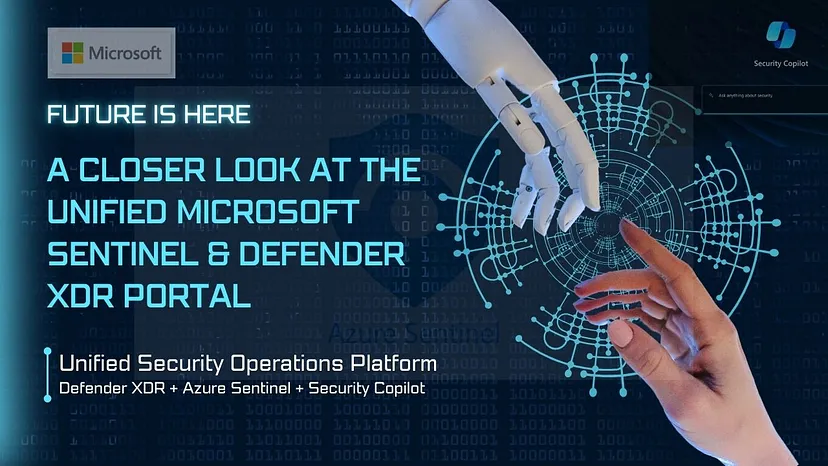A Closer Look at the Unified Microsoft Sentinel & Defender XDR Portal🛡️🌐
Combining Security Copilot, Defender XDR, and Microsoft Sentinel into one unified portal sounds like a dream come true for security engineers and analysts
TLDR; Microsoft has finally announced the public preview of its long-awaited integration, merging Defender XDR and Azure Sentinel into a unified portal, offering customers a streamlined security experience. Customers with a single Microsoft Sentinel workspace and at least one Defender XDR workload can enjoy this unified experience in a production environment. Onboarding is quick and seamless, and users can now leverage Microsoft Copilot for Security.With the addition of Copilot for Security in the Defender portal, analysts benefit from a 22% increase in speed, expediting incident resolution.?
Before Start
Cognitive hub for security analysts by GenAI
Introduction
Back in November 2023, Microsoft made a huge announcement. They introduced something called the Unified Security Operations Platform. This news spread like wildfire in the cybersecurity world. People were excited, especially those who loved security analytics. They knew this could change everything, making it easier to find and stop cyber threats. It felt like a big moment for cybersecurity. Fast forward to today, and that big moment is finally here. Microsoft is doing something even bigger now. They’re bringing together two powerful tools: Defender XDR and Azure Sentinel. Plus, they’re adding something new called Security Copilot. This trio is going to revolutionize how security teams work. It’s like giving them superpowers. With these tools working together, security experts can protect systems better than ever before. It’s a game-changer for cybersecurity (Picture of unified portal is attached below):
Credit — Microsoft (Unified Copilot, Defender XDR and Sentinel Portal)
The Unified Microsoft Sentinel & Defender XDR Portal
We all know the Unleashing the Power of Microsoft Sentinel and Defender XDR. At one side Sentinel can sift through mountains of security data in real-time, spotting suspicious activities and potential threats lurking in an organization’s digital landscape. With its keen eyes, Sentinel gives security teams a bird’s-eye view of their infrastructure’s security posture, pulling together logs, events, and alerts for a comprehensive analysis. On the other side, When Defender XDR detects something suspicious, it doesn’t waste any time. It jumps into action right away! With its automatic investigation and response features, it works quickly to stop security problems before they cause chaos for the organization.
Now, imagine these two superheroes teaming up. 🦸♂️🦸♀️ That’s exactly what happens when Microsoft Sentinel and Defender XDR join forces. Their integration creates a seamless collaboration that boosts incident response capabilities to new heights. Sentinel acts as the central command center, providing analysts with a clear view of the battlefield. Meanwhile, Defender XDR feeds it valuable endpoint telemetry, enriching the data and giving analysts the context they need to take swift and decisive action against threats.
Onboarding Microsoft Sentinel to Microsoft Defender XDR
Microsoft Sentinel onboarding to Microsoft Defender XDR is now available for public preview. Microsoft has provided official documentation for all these changes. You can visit the official documentation here to learn more about onboarding Microsoft Sentinel to Microsoft Defender XDR.
Pre-requisites: https://learn.microsoft.com/en-us/microsoft-365/security/defender/microsoft-sentinel-onboard?view=o365-worldwide
Key Advantages of Defender XDR and Sentinel Integration
5 key benefits for security analysts when Defender XDR and Sentinel are given below:
Unified Experience for Improved Efficiency:
With the integration of Defender XDR and Sentinel into a unified platform, security analysts can bid farewell to the hassle of navigating between multiple portals and workflows. This consolidation knocks down security silos, allowing analysts to focus more on high-value tasks such as remediating incidents fully and reducing future attack likelihood.
End-to-End Visibility for Better Risk Management:
The unified platform provides end-to-end visibility of an organization’s attack surface. Analysts gain comprehensive insights into various exposures, including vulnerabilities, misconfigurations, and overprivileged access. This visibility enables proactive risk management across the entire digital estate, helping to prevent breaches before they occur.
Automated Attack Disruption for Swift Response:
In today’s threat landscape, where attacks are becoming increasingly sophisticated and rapid, automation is crucial. The platform leverages the power of XDR and AI to automatically disrupt advanced attacks like ransomware and business email compromise in near real-time. This capability not only stops attacks in their tracks but also gives precious time back to analysts for triage and resolution.
Faster Investigation and Response:
The unified incident queue and robust out-of-the-box rules provided by the platform significantly reduce incident overload and improve alert correlation. This leads to faster acknowledgment and response to security incidents. Additionally, unified hunting capabilities eliminate the need for analysts to navigate multiple dashboards, reducing investigation time and accelerating incident resolution.
Intelligent Assistance with Microsoft Copilot for Security:
Microsoft Copilot for Security serves as an intelligent assistant embedded within the analyst experience. It helps analysts accelerate incident triage by providing comprehensive incident summaries, reverse-engineering malware, and suggesting multistage attack remediation actions. This assistance not only saves analysts time but also enhances their skills and capabilities.
Conclusion
In wrapping up, I truly believe that the integration of Defender XDR and Sentinel into a unified platform is poised to revolutionize cybersecurity operations centers (SOCs). The benefits we’ve discussed for security analysts are incredibly promising, offering improved efficiency, visibility, and response capabilities. It’s like we’re on the cusp of a whole new era in cybersecurity! I’m genuinely excited to see how this integration unfolds and how it transforms the landscape of SOC operations. Here’s to embracing this revolution and witnessing its incredible potential in action.
Latest News
Every week we publish exclusive content on various topics.





